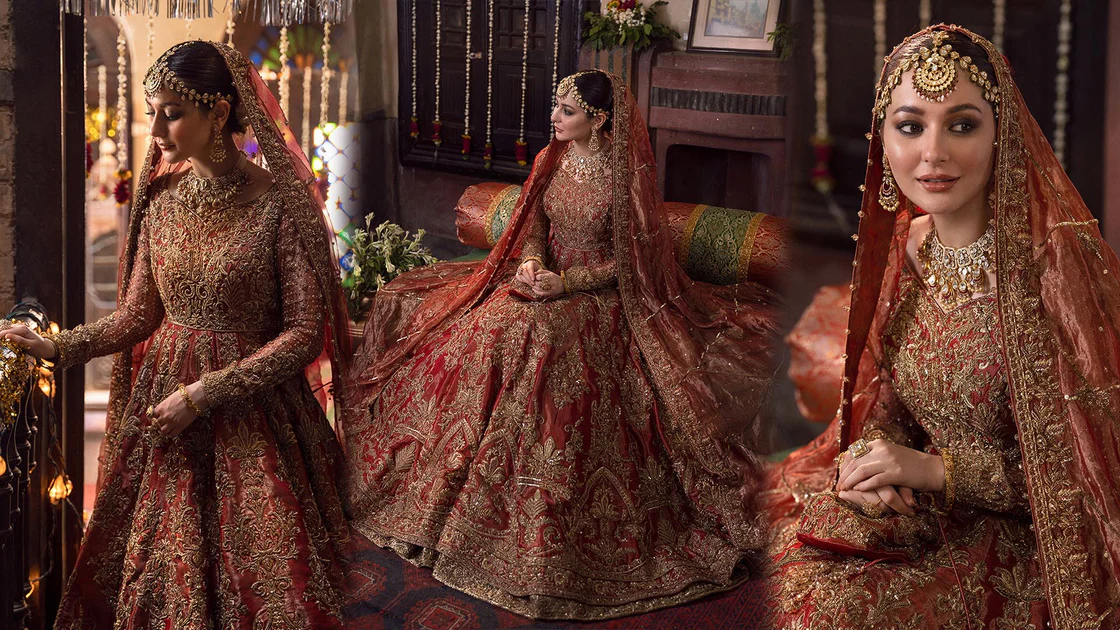Pakistani clothing is a vivid testament to the country’s rich cultural tapestry. Known for its intricate embroidery, vibrant fabrics, and elegant silhouettes, Pakistani fashion blends traditional charm with contemporary trends, making it perfect for special occasions. From weddings to Eid, each event is an opportunity to showcase the beauty of Pakistani traditional dress. The extensive use of luxurious materials such as silk, chiffon, and velvet, along with richly decorated fabrics, speaks volumes about the craftsmanship involved. Each piece, be it a sherwani for men or a lehenga for women, reflects the profound cultural heritage embedded within what can truly be called Pakistani dress.
1. Wedding Extravaganza
Weddings are the pinnacle of Pakistani social life, where the dress code is nothing short of spectacular. For such occasions, women typically wear lehengas, shararas, or ghararas.
- Lehengas are long, embroidered skirts worn with a matching or contrasting blouse, known as a choli, and a dupatta. The embroidery often features zari, beads, and stonework, making the outfit dazzle under the lights.
- Shararas are wide-legged pants that flare out dramatically from the knee downwards, paired with a long blouse. This outfit is particularly favored for its blend of traditional aesthetics with comfort.
- Ghararas consist of pants that are fitted till the knee and flare out heavily from the knee downwards, often in ruffles. This outfit is teamed with a short, body-fitted kurti and a dupatta, which adds grace to the entire ensemble.
For men, weddings are an occasion to don the sherwani, a long coat-like garment worn over a kurta and paired with a churidar or salwar. Rich fabrics like silk, brocade, and velvet are preferred, often adorned with subtle embroidery.
2. Eid Celebrations
Eid is another occasion where Pakistanis pull out all the stops in terms of dress. Women often opt for salwar kameez, which is considered comfortable yet stylish. The kameez can be long or short, depending on the trend and personal preference, paired with a well-fitted salwar or a more breezy palazzo pant.
Recent trends have seen the rise of the anarkali suit, which is a long, frock-style top worn with a slim fitted bottom. This outfit is renowned for its ability to combine grandeur with grace.
The dupatta is an essential aspect of Eid outfits, often heavily embroidered or made of delicate chiffon with lace edges. It’s not just a piece of cloth but a symbol of modesty and respect in the Pakistani culture.
Men typically wear kurta pajamas or a more formal shalwar kameez during Eid. These are often made from lighter fabrics like cotton or linen for daytime events, with darker, richer fabrics like silk used for evening celebrations.
3. Festive Parties
For more casual, yet festive occasions, the Pakistani tunic or kurti can be seen. These are versatile and can be worn with jeans for a more modern look or with a traditional shalwar for a classic approach. Embellishments such as mirrors, embroidery, and block prints elevate these tunics into the festive category.
Accessories play a crucial role in enhancing the Pakistani outfits—be it through heavy jhumkas (earrings), chokers, or large, ornate bangles. Shoes are typically traditional khussas or embellished heels, depending on the level of formality of the occasion.
4. Designer Influence and Couture
Pakistani designer wear is a realm of its own. Designers like Elan, Sana Safinaz, and Maria B have taken Pakistani fashion to international ramps, where they are applauded for their innovation and finesse. These designers play with silhouettes, embroideries, and fabric combinations to create unique pieces that are modern yet deeply rooted in Pakistani artisan traditions.
5. Fabric Choices
The choice of fabric is integral to Pakistani fashion. Luxurious silks, breathable cottons, lush velvets, and ethereal chiffons are commonly used. Each fabric is chosen to suit the weather, occasion, and the specific cuts and designs of the garments.
6. The Global Stage
As globalization shrinks the world, Pakistani fashion too has found a comfortable niche in international markets. With online shopping and global shipping, Pakistani outfits are just a click away for the diaspora and other international customers interested in ethnic wear. Moreover, global fashion platforms often showcase Pakistani designs, highlighting the rich cultural underpinning of this beautiful attire.
Adapting Traditions to Modern Needs
The evolution of Pakistani fashion is not only evident in the intricate designs and patterns but also in how these traditional outfits are adapted to meet contemporary needs. As lifestyles become more dynamic, designers are crafting styles that maintain cultural authenticity while ensuring comfort and practicality.
Take, for instance, the modern reinterpretation of the shalwar kameez, which has seen transformations in its cut and style to fit a more global aesthetic. The kameez lengths vary from mid-thigh to knee-length, tailored to flatter different body types and preferences. Fabrics are also chosen based on their ability to drape well and maintain shape throughout the day, catering to the busy lives of modern women.
For men, the traditional kurta has seen a similar evolution. It’s now common to see kurtas paired with jeans or trousers for a fusion look that fits seamlessly into both casual and semi-formal settings. This blend of traditional and modern elements appeals to the younger generation, who look for versatility and style in their clothing.
Conclusion
Pakistani clothes are not just garments; they are a celebration of cultural heritage, an exhibition of intricate craftsmanship, and an embodiment of aesthetic elegance. Whether it’s the radiant colors of a Mehndi outfit or the sophisticated embroidery of a bridal lehenga, each piece tells a story of centuries-old traditions mingling with the modernity of today’s fashion world. For special occasions, wearing Pakistani clothes is a way to connect with one’s roots while making a stylish statement.



